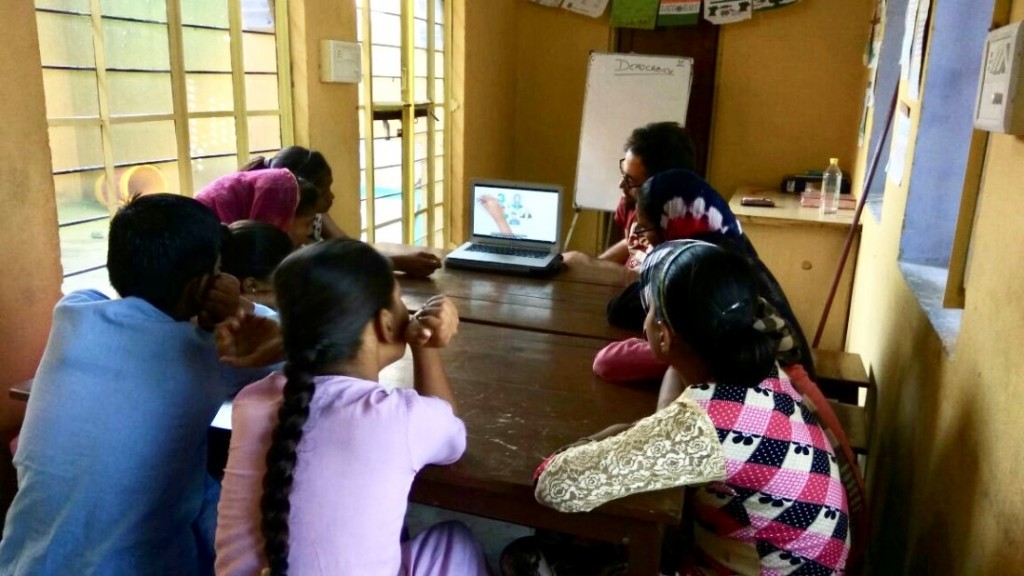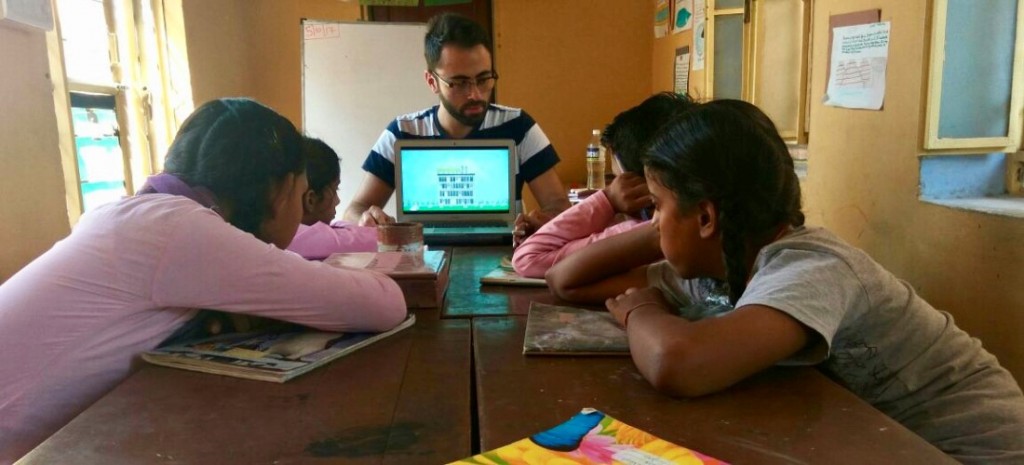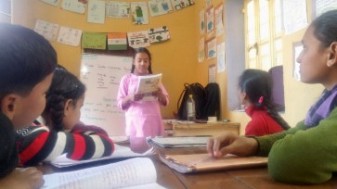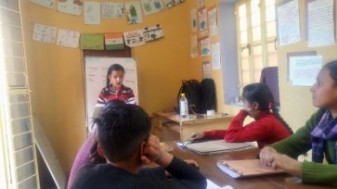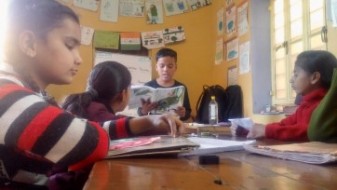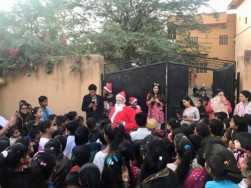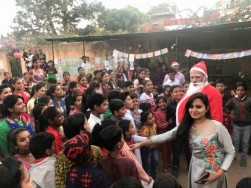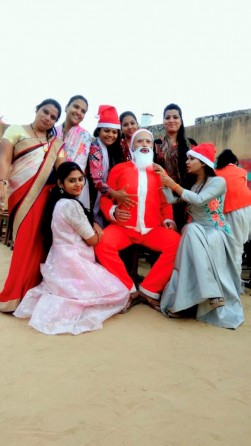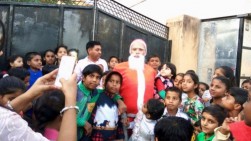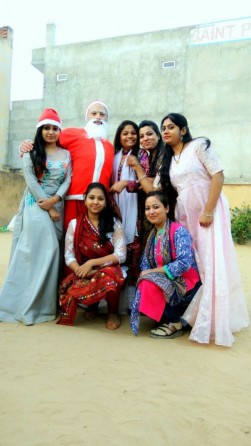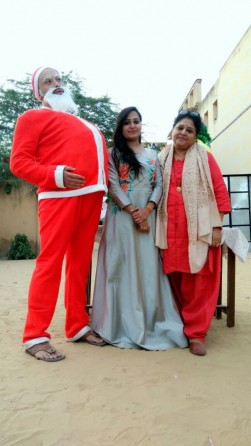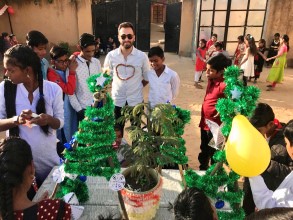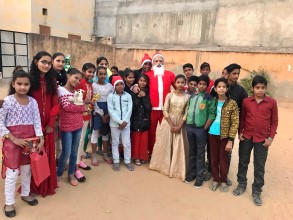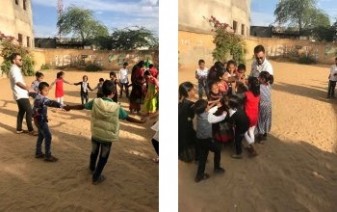Blog posts by Dimitris Chaidas
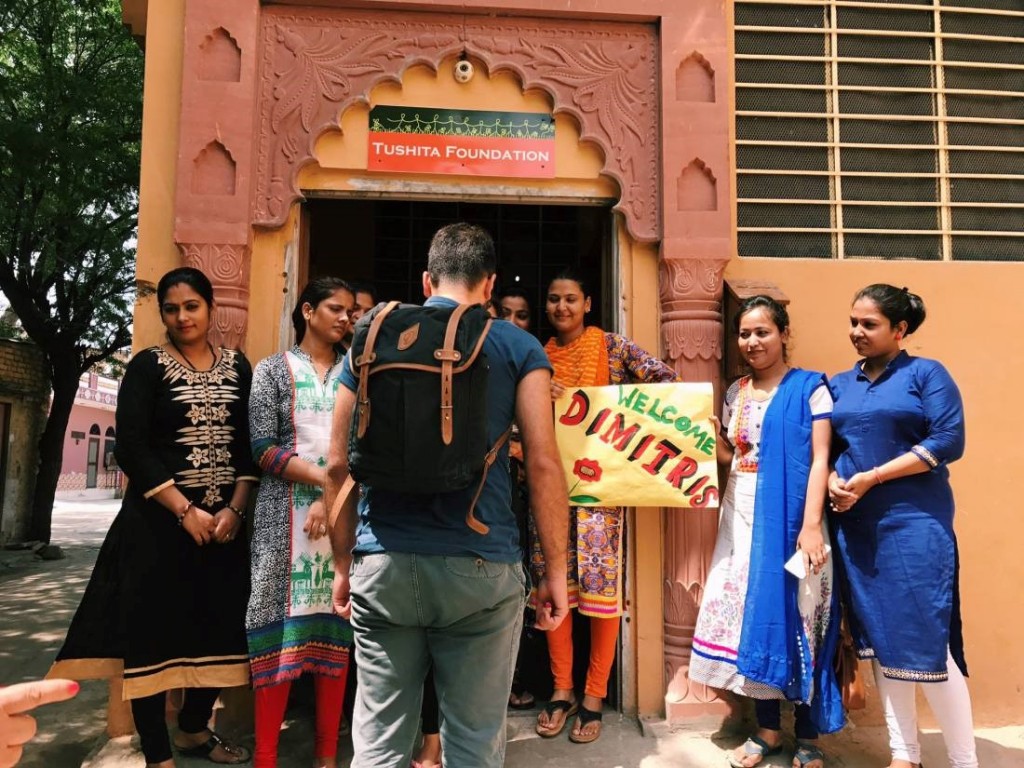
“Everything is Pink in my Garden”: The beginning of a new journey
“I did not know what to expect from India or Jaipur”, this sentence was one of the first things I told Ankita, the programme coordinator, and Ana, the second volunteer at Tushita Foundation, upon my arrival at the airport of Jaipur. I was thrilled, but also sceptical. Eager and, at the same time, hesitant. First time in India…first time in Asia…first time outside Europe.
On my way to Tushita House, the place where I would stay until the end of my internship, I was looking out of the car window. Movement, sounds, colours, the high temperature… everything was triggering my senses. Without having realised where I was, I found myself outside Tushita House, my new home. Veenaji, the mother figure of Tushita Foundation, and of course Virendraji and Bheem, the people who would be my everyday companions, were all there to embrace me and to make me feel comfortable. All of them with a big and welcoming smile on their face to incorporate me in the Tushita House. By the end of the first day, I was calm, satisfied and curious about what the Foundation itself will be like. But my initial question remained: “Will I enjoy this experience?”
The big day of my first exposure to the Foundation arrived two days later. After a long trip through the city of Jaipur, the car which carried me, Ana, Ankita, Veenaji and Virendraji stopped. An image was right in front of me. An image of a building with the logo “Tushita Foundation” and, in front, eight happy faces staring and smiling at me. I approached and bowed my head before the teachers of the Foundation. A garland of flowers, a tilak on my forehead, some rice throwing and a big ‘Welcome Dimitris’ banner made feel like from then on I was one of them.
Deconstructing sports: the case of the Olympic Games
If I could summarise the project that I am currently conducting at Tushita Foundation in one sentence that would be the following: the development of the children’s communication skills and critical mind. As a linguist specialised in (Critical) Discourse Analysis and Second Language Acquisition, my goal for the kids is to train them to become independent speakers of English, able to present their thought clearly and effectively in front of an audience and while participating in a discussion. The improvement of their argumentation skill, namely the skill to make statements grounded in justifications and evidence, is the focus of my project.
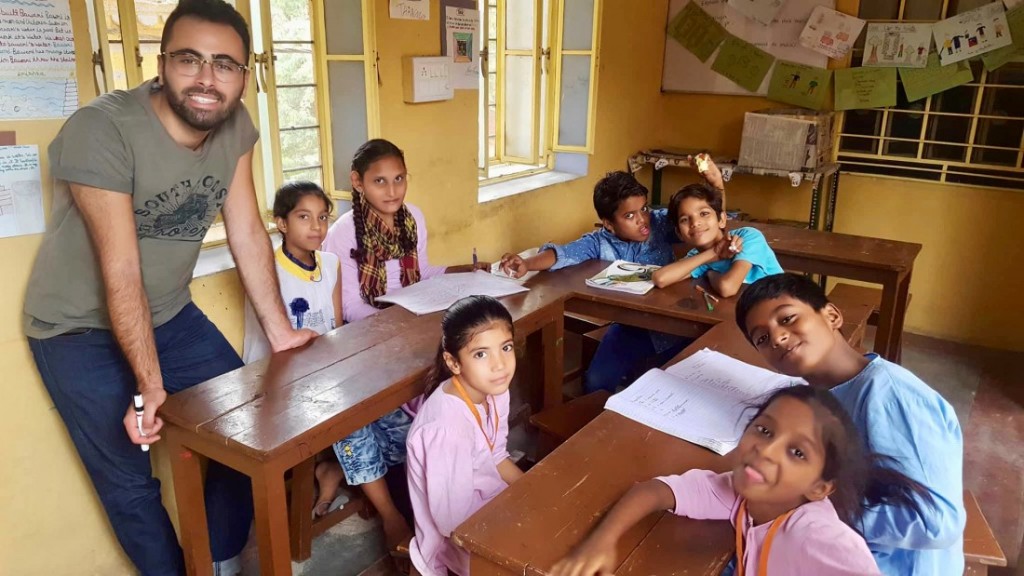
After the end of our class, we all strike a pose.
For my first encounter with the Rose class and the Lily class as a teacher, I chose the Olympic Games as week 1’s topic. During the first session, the children had the opportunity to watch a short video from the opening ceremony of the 2004 Olympic Games in Athens, Greece. Using media appeared to be a successful way for sparking the kids’ interest. After the end of the video and some information about the Olympic Games that I provided them with, we discussed about the Olympic Games’ value and the lessons one can learn from them. My aim was to make the children think themselves about the importance of sports in our life and why they play sports. At the end of the first session, the Olympic values of friendship, respect and excellence together with the four Paralympic values of determination, inspiration, courage and equality were not only embraced by the students, but they also advocated their role in modern societies. During the second session, the children learnt new vocabulary related to the Olympic Games and, in general, sports. Additionally, the second session was oriented in the cultivation of the kids’ writing skills. Thus, they were asked to use the new vocabulary for the production of a text of two paragraphs. In that way, I was able to identify both the level of the vocabulary’s acquisition by the students and their proficiency level. After the end of this exercise, the class included some grammar teaching. This week’s grammar session was focused on modal verbs (may, might, can, should/ought to, must, have/has to) and their different use and meaning in our discourse. The teaching procedure involved the kids themselves through their citation of examples in which they use each of the modal verbs. As a result, the kids were able to handle the new knowledge and managed to infer the unique usage of each modal verb on their own. Now that my first week has come to an end I can say that I am very happy with the kids’ response and their eagerness to continue this project with me. I am already looking forward to seeing its results and the growth of my students.
Democracy: approaching its history and place in India and the world
After a busy weekend at the Tushita Foundation, where all the volunteers and the staff alike helped in checking the students’ health, a new week full of new knowledge and fun started last Monday. The classes were oriented in the teaching of the structure of paragraphs and the role of democracy in modern societies, like India. To begin with the first part, my classes focused on the text production and, to be more specific, the parts of a text, namely the paragraphs. In order for the kids to be able to present their thoughts in a clear and successful way, they first needed to learn the parts of a paragraph: the topic sentence, the supporting details and the concluding sentence. After having practiced on some paragraphs-examples with my help and under my guidance, the kids were asked to produce their own text. All of them managed to produce a paragraph successfully and, at the same time, to incorporate the tripartite structure. This class helped them understand that, when one speaks or writes, s/he needs to have a topic and elaborate on it in such a way that the reader or interlocutor is able to understand the issue under discussion. The difference between the way in which the kids used to write before this class and the way in which they managed to write during the class was significant.
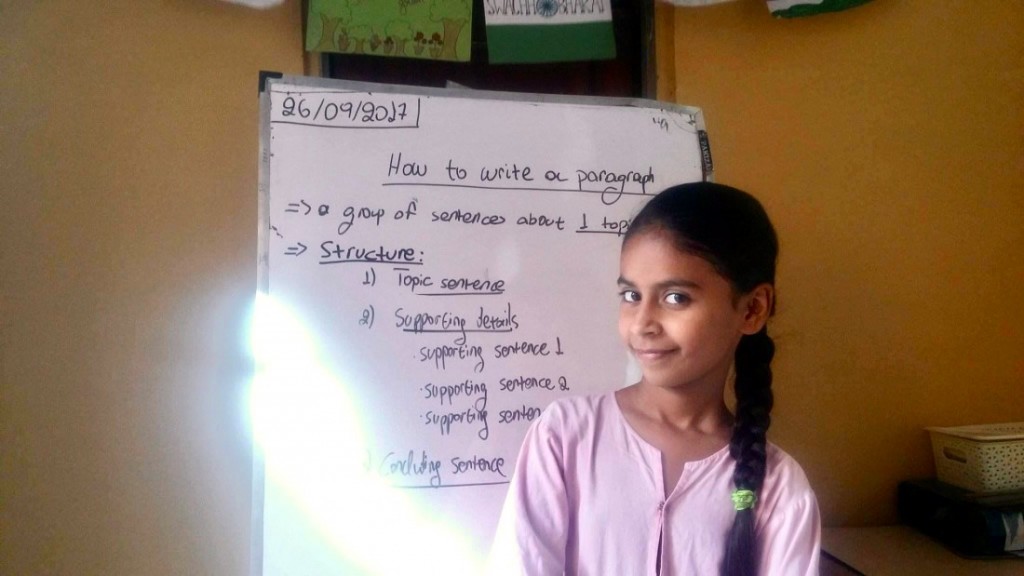
Learning about the structure of paragraphs
The second part of my weekly work at the Foundation included the teaching of and discussion about democracy. First, I presented one picture of India’s Parliament to the kids and, when they recognised the building, the class on democracy started. After I had explained what is the meaning of the word ‘democracy’ and how democracy used to work in ancient Greece (Athens), the kids and I watched a short introductory video on democracy.
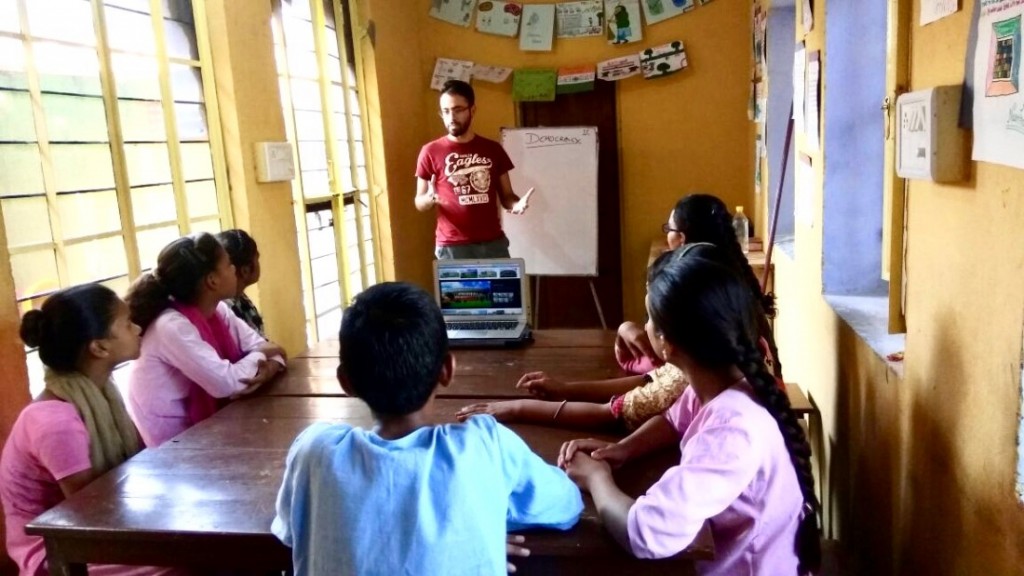
One picture of India’s Parliament to kick off this week’s topic
The interest of the kids was greatly sparked when we started discussing about the importance of democracy in our everyday life. Rights and ideas such as the freedom of speech and thought, the equality for all regardless of gender, race or religion and the active participation of citizens in their country’s future (through the elections) were not only understood by the students, but they also advocated the role of democracy in modern societies. Democracy was juxtaposed to tyranny and the practices of rulers who are not elected by the people of a country. The kids received prompts (questions) and had to think about the difference of the two systems of government and the implications that these have on the people’s everyday life. I was positively surprised by the fact that the children presented arguments based on the theory they learnt. Albeit initially unsure if the kids would find this topic interesting, they were happy with what they learnt and the importance of learning and discussing about topics like democracy. Their active participation during this class was the best reward for what I hope to achieve at the Foundation.
Animal testing: a short introduction
After a break of four days and a trip to the cities of Mathura and Agra, a new educational week at the Foundation started. For this week, I wanted to introduce the students of the Rose Class to the debate regarding animal testing. In other words, I attempted to discuss about the practices that are commonly implemented for the production of medicines and cosmetics. I started this topic by asking the kids if they knew how the medicines and the cosmetics are produced. Some of the students already knew that animals (especially rats and mice) are tested for that cause. Just like I have done every week so far, I kicked off my class by showing them a video on the topic. This time, an animated educational film was selected and served as an appropriate way for familiarising the students with a topic like animal testing. The link of the video is the following:
Questions about the video itself preceded questions about the week’s topic. The children had to answer questions of the type: “What was the video about?”, “What is the speaker’s point of view?”, “Does he agree with animal experiments or not and why?”, “Does he offer any alternative solutions?”. Then, a discussion started and the kids were asked to give their opinion on animal testing and support their statement with arguments. All the kids appeared to understand how the animals are treated in laboratories and they were very empathetic. Especially in the case of cosmetics production, they were straightforward: animal experiments should stop and be substituted by other methods. Among all the topics that have been covered so far, the kids’ interest in this week’s topic was arguably the keenest.
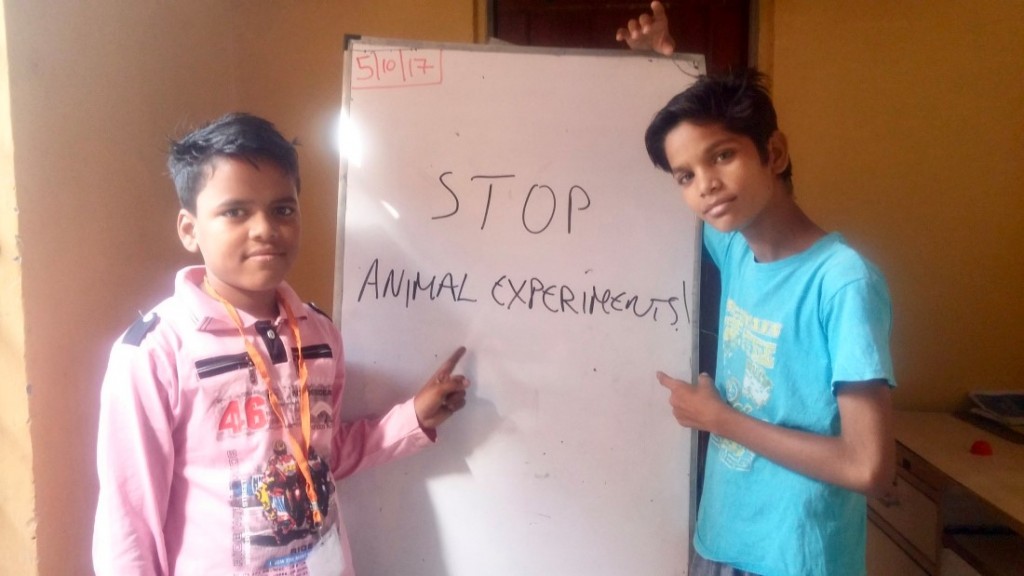
Jayant and Vishal highlighted the need for a change
The second half of the week was dedicated to grammar teaching. After four weeks of checking texts and paragraphs written by the kids, I realised that they need to revise what they know about the tenses. This time I started with Present Simple. Its teaching did not take place in the traditional way, that is by offering the kids the theory and then practicing with examples. What I chose to do instead was to start with some examples that the kids themselves came up with. The class focused on both correct examples and mistakes. The kids had to analyse and explain to everybody why they made the choices they made. In that way, the theory of Present Simple emerged from the examples themselves. At the end, we continued working on sentences-examples. The kids managed to incorporate the knowledge successfully and they were able to use Present Simple in their discourse in a grammatical way.
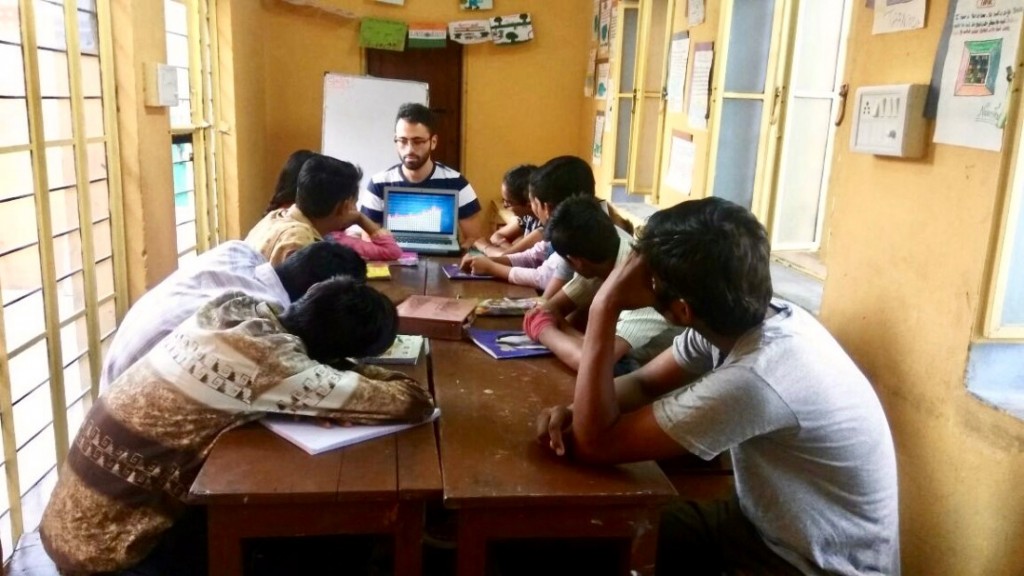
Happy to see that the kids are interested in the topic. P.S. I think should change the arrangement of the desks for next week’s video:D
Arts: approaching their place, role and value in our lives
This week has been special in the sense that the atmosphere at the Foundation, just like in the city of Jaipur, has been festive. The excitement and the anticipation for the celebration of Diwali created a very positive context for this week’s classes. The creativity and the imagination that the local people have shown so far for the preparation of the festival made me decide to choose the Arts as this week’s topic. Following last week’s pattern, a video was shown to the kids. A scene from the movie ‘Avatar’ was used by me to spark the attention and the interest of the kids.
My goal was to introduce them to the world of the Arts through (perhaps) the most widespread art, that is cinema. The discussion that followed the video centred around the different kinds of Art that exist and the kids know: the visual arts – including drawing, painting, photography, ceramics, sculpting and architecture; the performing arts – among them music, theatre and dance; and, of course, literature. The kids were surprised by the fact that there are so many arts. Moreover, they did not know that photography and architecture were both arts, for example. The kids received questions (prompts) and had to reflect on the video they watched in order to figure out some characteristics of the arts. I wanted them to realise why humans since the beginning of recorded history attempted to create works of art. The kids gave me multiple answers and they managed to infer from the video that arts foster our imagination, creativity, perspective and make the world more beautiful. Some kids, like Prachi, offered me and her classmates interesting views and answers on the topic. When she told the whole class that arts make people feel and think free I was positively surprised. Apart from the differences between the arts, I was constantly trying to show the kids the similarities that they share, with the story-telling character being their most common feature. Some kids looked a bit sceptical when I was trying to explain to them how arts like music and dance tell stories just like literature or painting. Their first exposure to this comparative approach of the arts was successful. By the end of the class, they were able to tell the similarities and dissimilarities among the arts.
At the end of our discussion session we all watched a second short video on the views of other students on the arts and we all paid attention to the answers that were given. Then, we talked about the importance of the arts and we compared the answers that my students gave with the answers of the kids in the video. Moreover, the children learnt new words related to the arts and they enriched their vocabulary. I am quite satisfied with the participation of the kids and their ability to communicate their views. After more than one month at the Foundation, I can notice some improvement of the communication skills of the kids and this makes feel particularly happy.
During this week I also worked with the kids on Present Simple and Continuous. We revised the theory together and we spent much time on examples and exercises. My main concern was to make them understand the differences between the two tenses in our discourse. I am confident to say that the kids showed a significant improvement and from now on they will continue to use the two tenses properly. If not, I will simply be there for them to help!
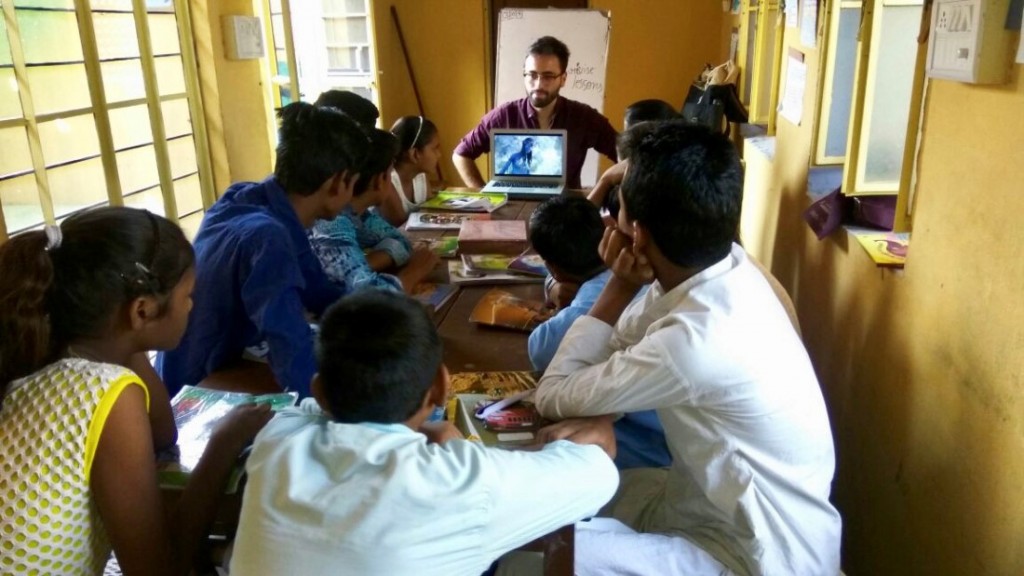
Rose class, Second Batch
Post-Diwali Grammar Classes at the Tushita Foundation
It’s been almost two weeks since the last time I wrote about my experience at the Tushita Foundation. Although I’ve been almost two months in India, this country continues to amaze me and provide me with some unique life experiences. Of course, I am referring to the Diwali festival which I had the pleasure to celebrate in Jaipur for one week. The city was beautifully decorated and its festive atmosphere offered everyone the perfect setting for the Diwali celebrations. After the end of this lovely break, all the volunteers and I returned to the foundation to start our classes again and continue our work for the education of the children of Amer.
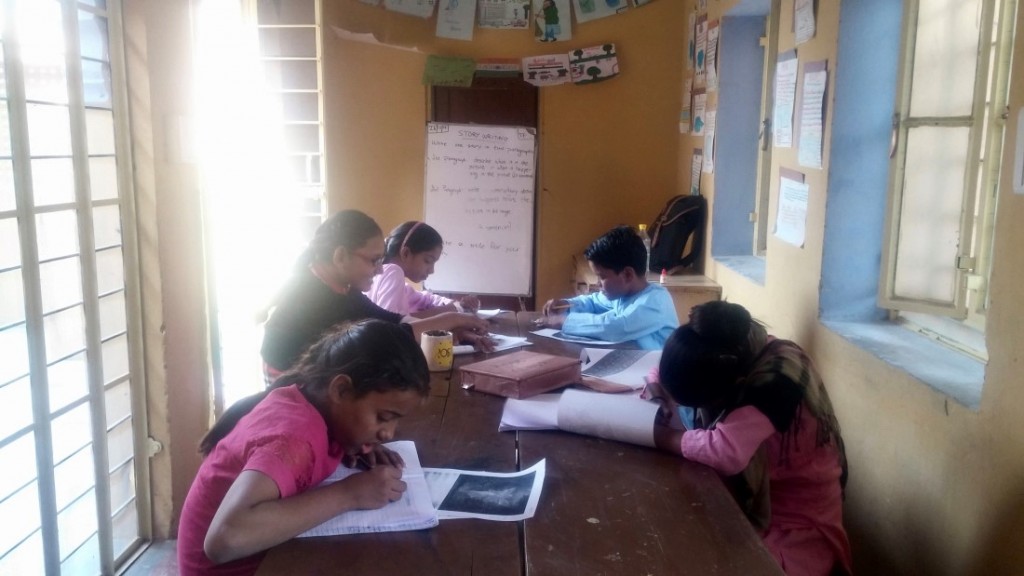
Through the eyes of a teacher
This week found my project slightly modified. After having been exposed to the kids’ proficiency level, I realised that more grammar classes are necessary for the improvement of the grammatical aspect of their speech. As such, I decided to dedicate the entire week to the revision of the tenses that the kids knew, that is Present Simple and Present Continuous, and the teaching of Past Simple, a tense that not all the kids appeared to be familiar with.
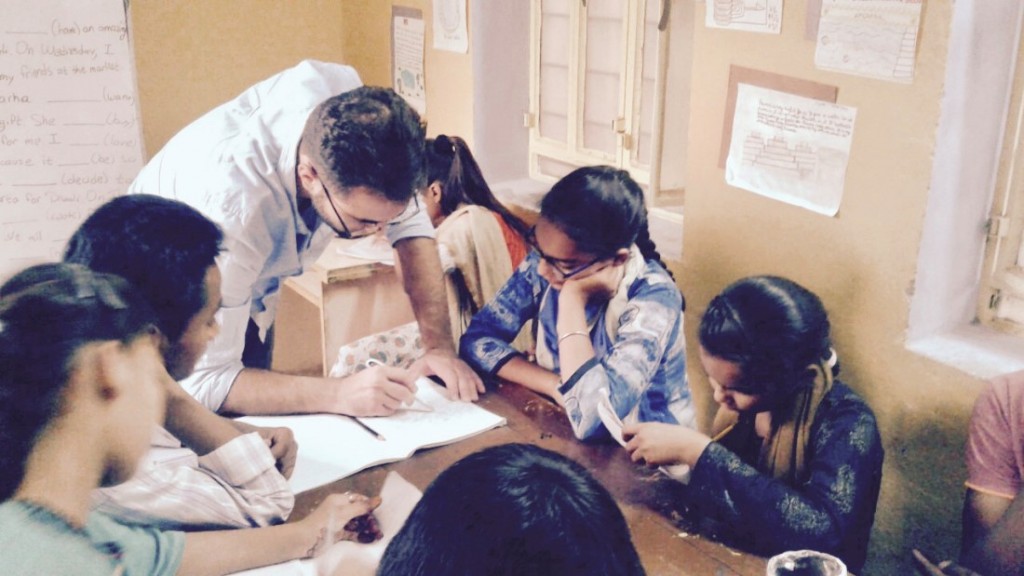
Credits to my friend and colleague Firdaus
Before I teach something new, I try to spend some time on summarising what has already been taught. On Monday, the kids revised the tenses of present under my guidance and with my support. They worked on examples and applied their knowledge to exercises. I was very happy to see the excellent use of Present Simple and Continuous by the kids. Moreover, they were able to choose the right tense when they wanted to speak about actions that happen regularly (Present Simple) or at the moment (Present Continuous). Tuesday and Wednesday were both dedicated to the teaching of the theory of Past Simple and the past tense of the most common irregular verbs we all use in our discourse. As I always aim to do in class, the teaching of the theory occurred through using an inferential approach. To wit, the theory was inferred by the kids after working on examples I gave to them. After this had been achieved, the kids applied their knowledge to an exercise on Thursday and Friday. The students were given images that were suitable for prompting story writing. They were asked first to describe what they see in the picture (in that way they had to use Present tenses) and then to think what was the image they were offered about. Their story had to include a scenario about what happened before the action in the image. Thus, the kids were led to use Past Simple in their story. This exercise seemed demanding to the children at the beginning. The fact that they had to come up with a story and use their imagination made them think that they would not write a nice story. Of course, my predictions that they would enjoy this exercise proved correct and the kids not only gave me some very good stories, but they were also happy while writing. They managed to use the tenses they know successfully and this made me feel very satisfied with their progress and the results of our collective efforts in class.
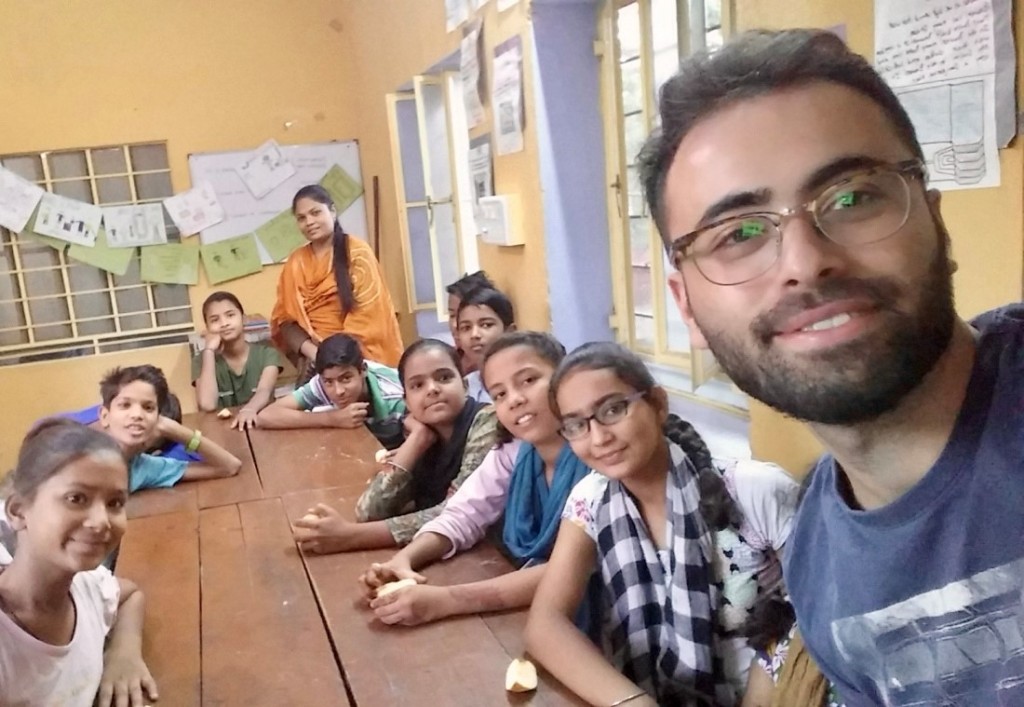
The students, Firdaus and I after the end of our class
I am half way through my internship at the Foundation. The first positive feelings I had during my first weeks have kept growing stronger and I am already looking forward to the continuation of my project. Both the bonds I have developed with my students and their constant improvement make me feel proud to be here.
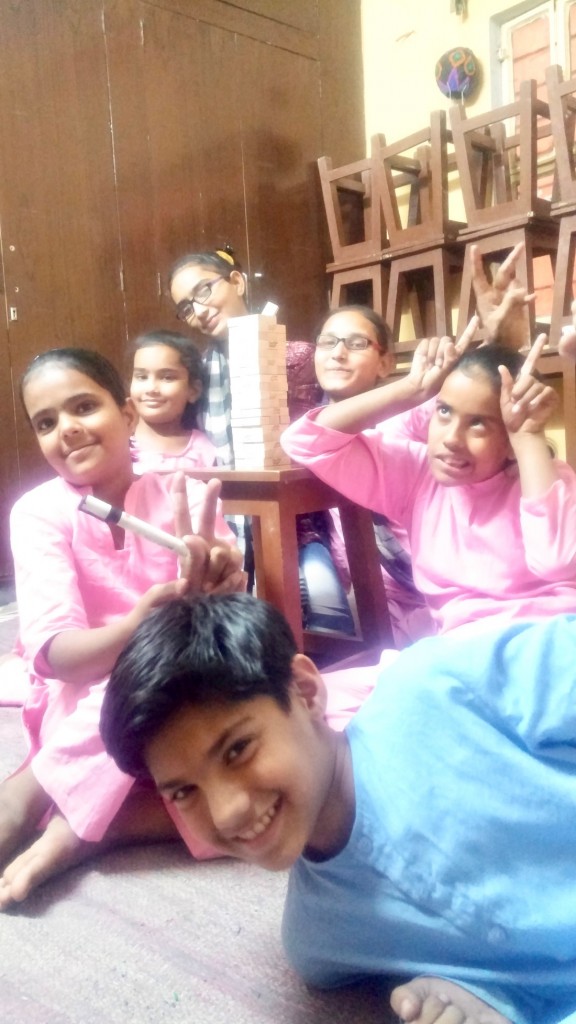
We played Jenga on Saturday and, as the picture suggests, we had fun!
My time with the Lilies
The first text I wrote about my internship at the Tushita Foundation was published more than two months ago. My work, my experiences, my relationship with the kids and the teachers, the special moments that we have shared together so far, they have all made time fly very fast.
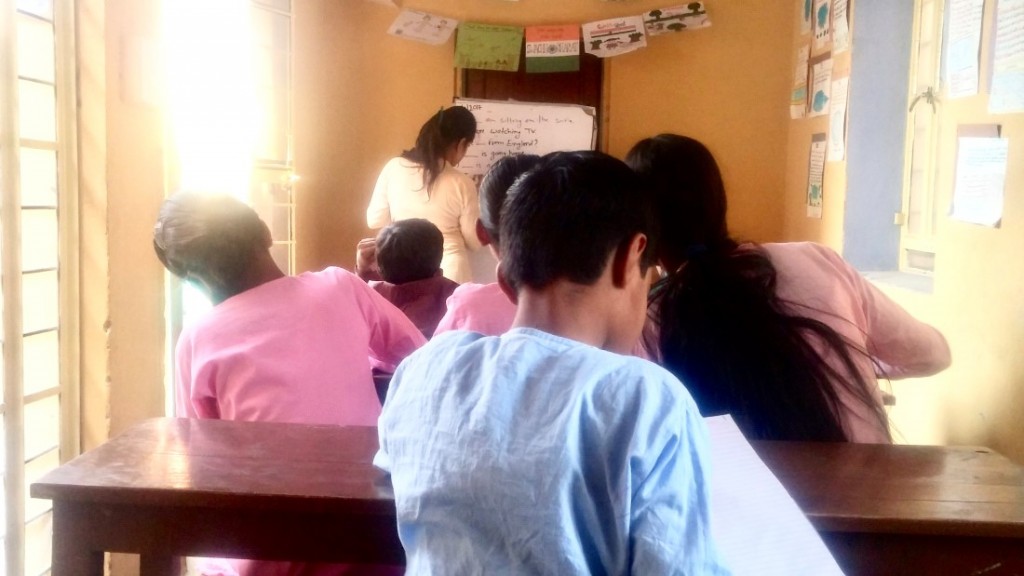
Payal writing some exercises for the students
I have spent the last couple of weeks with the second older class at the Foundation, the Lily Class. After working with the Rose Class for 1,5 months, it was good and refreshing to expose myself to new students.
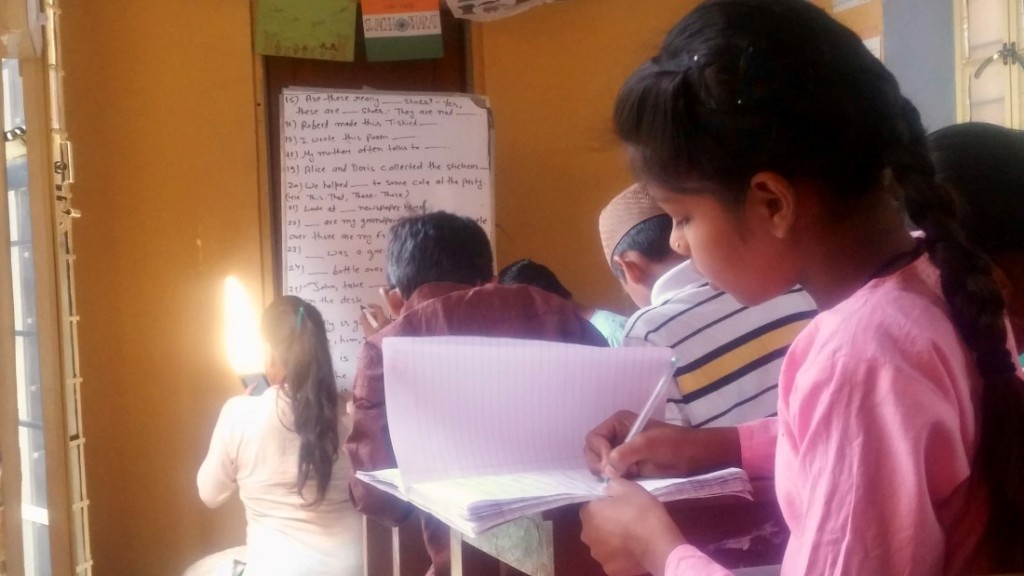
Palak focusing on her task
With the age difference comes proficiency difference. Having that in mind I first wanted to check the communicative level of the Lilies. Some group discussions in class as well as some written exercises showed me which sides of the children’s linguistic competence are the weakest. Unlike the Rose kids who can develop more original and complex linguistic structures in their discourse, the Lilies appeared to lack this skill which is related not only to the proficiency level, but also the age. The biggest weakness of the Lilies was their repetitive and one-dimensional discourse. To be more specific, when the kids were asked to write a paragraph or talk about a topic they kept repeating the same words, not due to vocabulary issues but mainly because they were not able to use pronouns. So, for example when the kids wanted to write something about the Foundation, they used to repeat the word ‘Foundation’ instead of using the personal pronoun ‘it’. This observation of mine made me decide to dedicate as much time as needed to change and improve the students’ repetitive discourse.
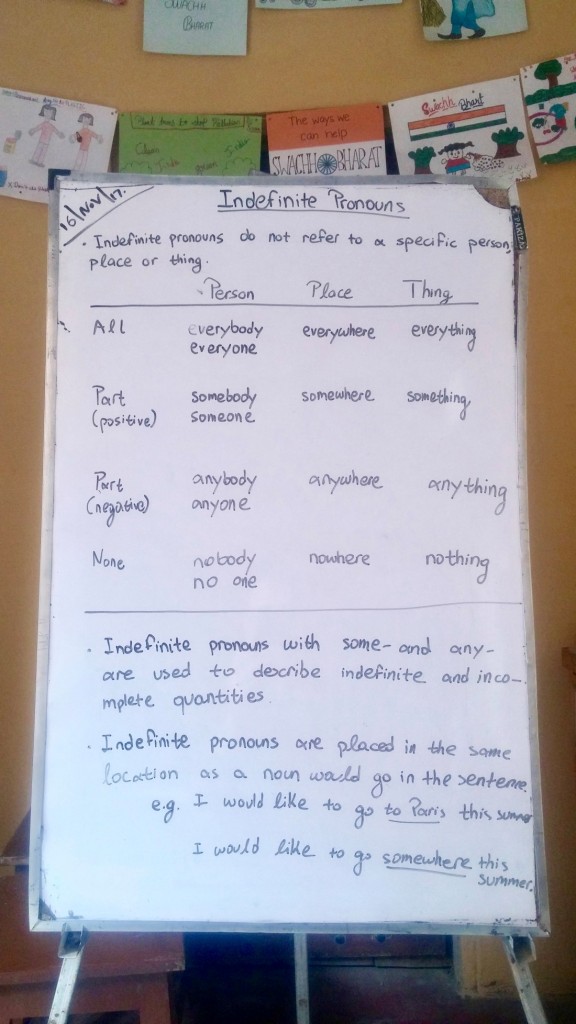
The most challenging pronouns for the Lilies: the indefinite group
This sub-project of mine took me almost two weeks. The classes focused on almost all types of pronouns: personal, possessive, demonstrative, reflexive (reciprocal), interrogative and indefinite. With the help of one of the teachers at the Foundation, Payal, I made an extensive use of helping material. Sentences and paragraphs in exercises helped the kids understand why we use and why we need the pronouns when we speak. Out of all the six types of pronouns that the Lilies learnt, five types were acquired very quickly. The only group that seemed to be the hardest for the kids to understand was the group of the indefinite pronouns. The students faced some difficulties in separating the no-pronouns from the any-pronouns. This obstacle, however, was one of the obstacles that all teachers face and need to tackle doing two things: showing patience and remaining determined. This was the case with the indefinite pronouns. The students managed to understand the difference between the no-pronouns and the any-pronouns as their performance during the test they had to write at the end of this sub-project indicated.
Now, I am only looking forward to our next sub-project!
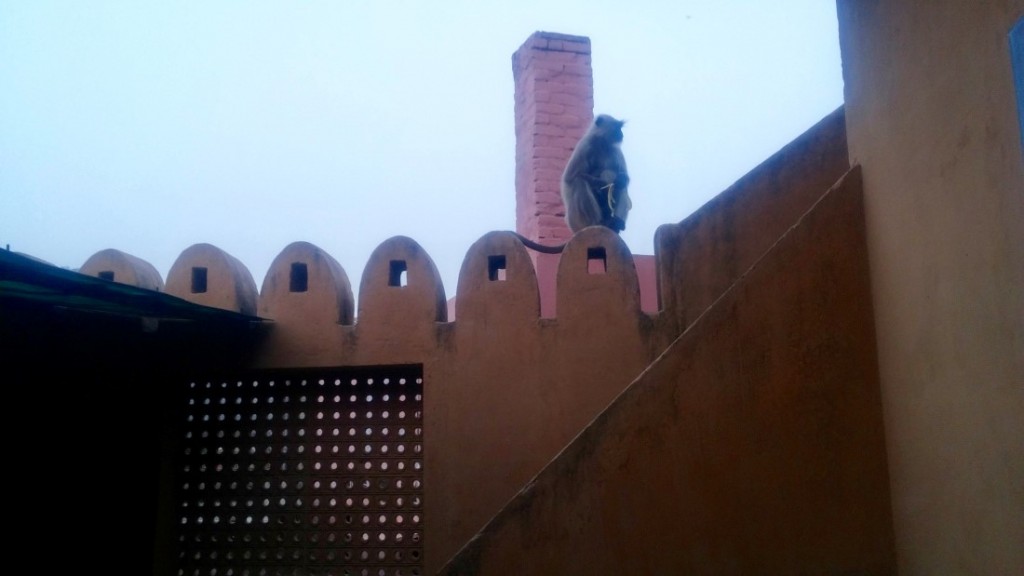
Our everyday visitor!
Learning how to write a text
One of the first classes I delivered at the Foundation regarded the paragraph structure and, to be more specific, how to write a paragraph in a systematic way. The rationale behind teaching the structure of the paragraph is the need to organise our thoughts before starting writing or speaking, so that the reader or interlocutor is able to follow the arguments made.
Building upon the knowledge that the students already have about the structure of paragraph which is the small unit (after the sentences) in a longer text, I started teaching the so-called “text structure” this week. Teaching the text structure means teaching the ways in which a writer (the students in our case) can organise the information s/he includes in a text. The importance of “text structure” lies not only in making arguments, but also in interpreting them.
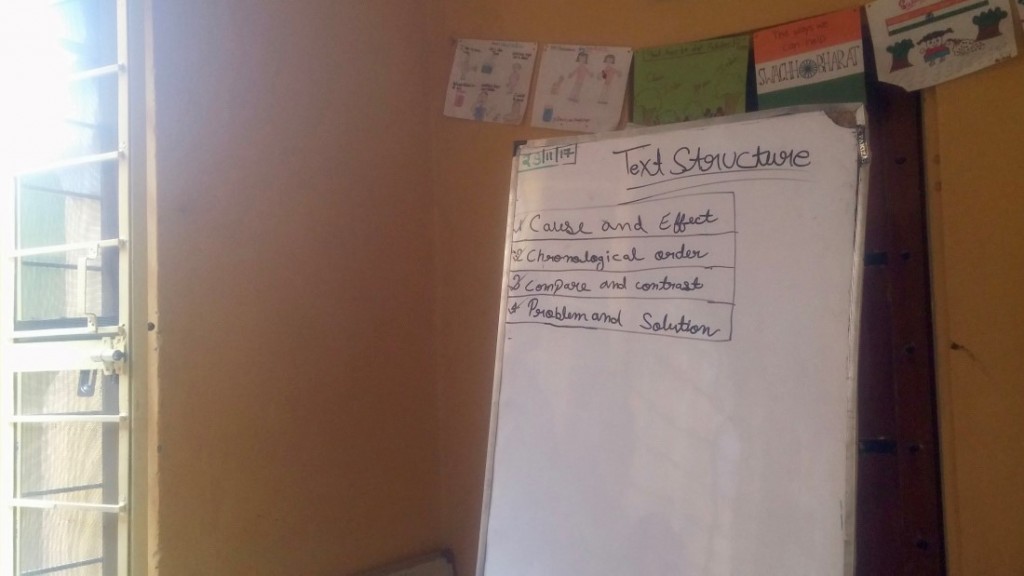
So, having that in mind I delivered several classes on the commonly used patterns of organising the text information, that is the cause and effect structure, the chronological order, the compare and contrast structure, order of importance and problem and solution structure. By providing the students with examples first and making sure they can understand the exercise itself, I went on to deliver the new theory on text structure. Despite the age of the rose kids, they appeared to lack the knowledge about text writing, since this type of class is delivered relatively late at schools. The kids were able to acquire the new knowledge surprisingly fast. Apart from the cause and effect structure which took the children some extra time to learn, all the other structures were easily understood as the written exercises indicated.
Since the classes this week were about text writing, the students were asked to produce their own texts while adopting the structure that I had asked from them each time. Today, for example, the students produced their own essays on the problem of obesity. By applying the structure of problem and solution, they managed to write a text about how we can all tackle obesity and adopt a healthy lifestyle. The texts that were produced were of high level, with Mehek’s and, especially, Lalit’s essays being of exceptional quality.
A steady improvement in the kids’ communication skills has been evident since my arrival here. This not only satisfies me as a teacher, but also motivates me to keep working hard for them.
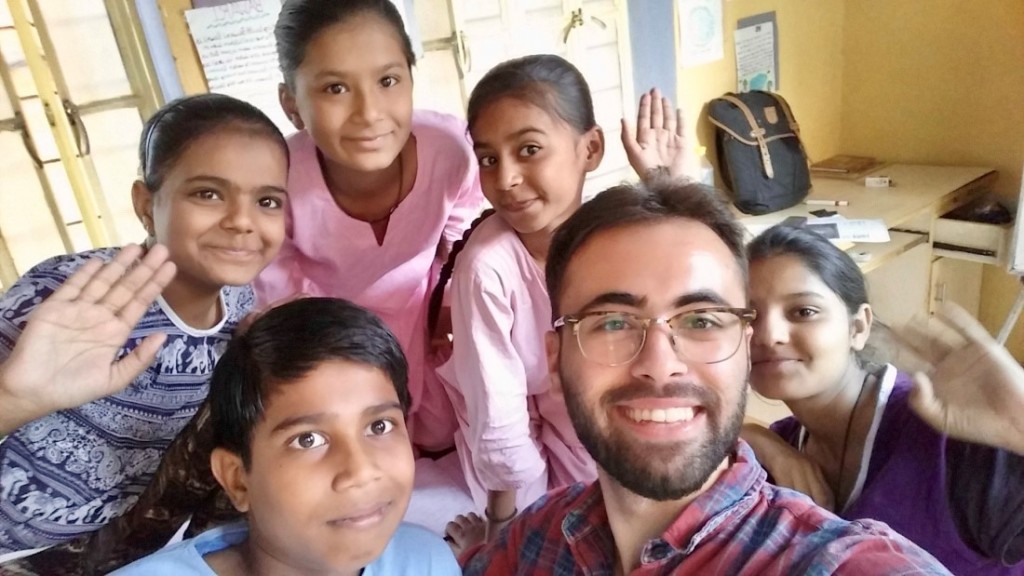
The Rose and I post-class selfies
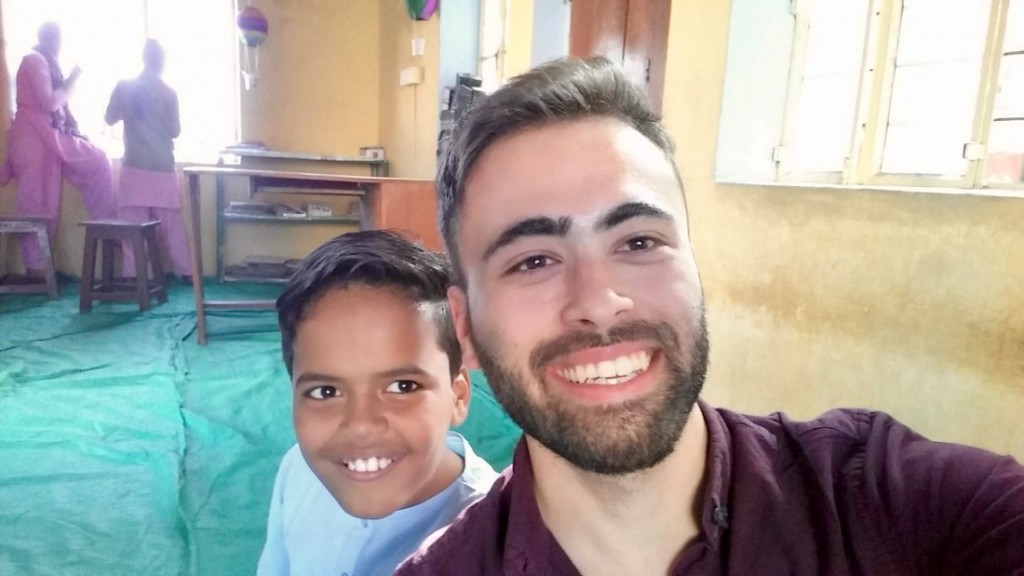
Jayant and I chilling after a two-hour dance
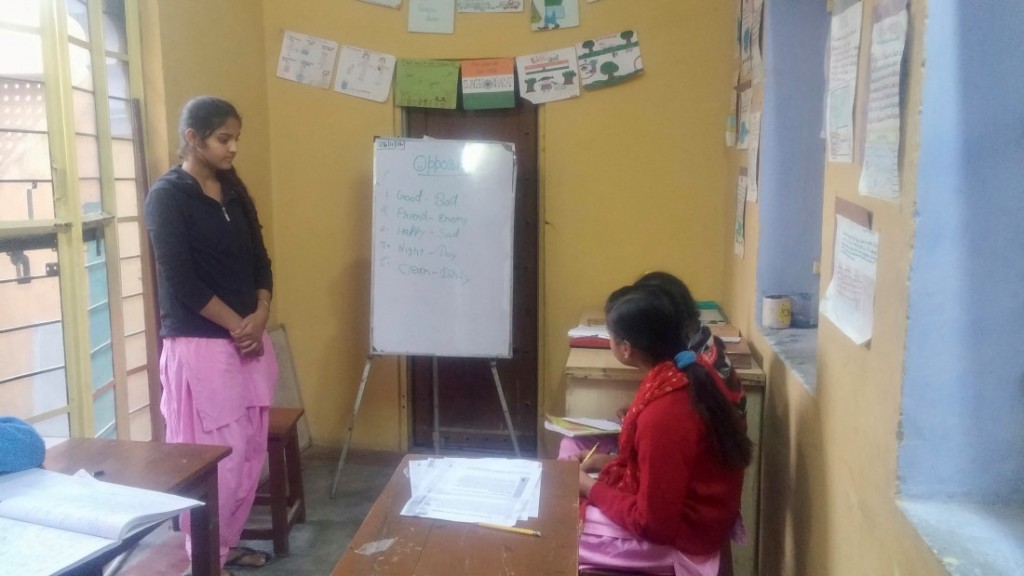
During the breaks, students can also become teachers as part of a role play game!
Teachers sessions and Text Structure vol. II
My time here in India continues to provide me with unique moments and experiences. After a four-day trip to the beautiful cities of Jodhpur and Jaisalmer, I returned to my duties at the Tushita Foundation where work and fun always await me around the corner.
This time I decided to write a post not only about my classes with the kids, but also another part of my work at the Foundation: my grammar classes with some of the teachers. To begin with, this week found me and the Rose class finish our sub-project on text structure. We worked on the two remaining patterns of text organisation: the order of importance and sequence/process writing. As I wrote in my last post, the teaching of text structure serves the skill to recognise and de-construct the way in which information is structured in a text in accordance with the aims of the person who writes or speaks. Since it is mainly a practical issue (apart from theoretical), I dedicated much time on exercises this week. To be more specific, the kids worked on texts-examples under my guidance and they were asked to find the main idea of the text, to give a suitable title to the given passage and recognise the textual pattern that was used by the author. This exercise which is not related only to the English language, but to the kids’ ability to handle textual information in general proved to be challenging for the younger students at the beginning. However, the two didactic hours that we dedicated and the big number of examples that we worked on together were very useful. All the kids managed to develop their understanding of information organisation in a text.
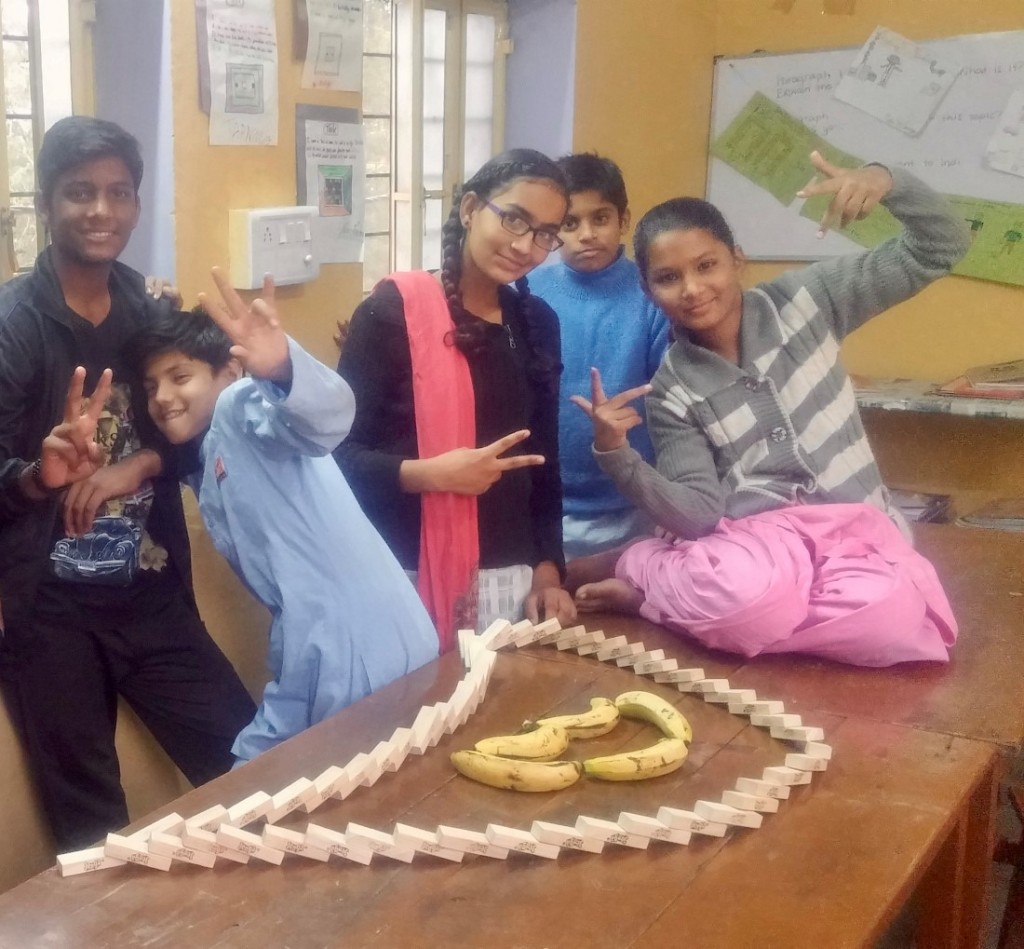
My students love Domino and they prapared a D for their Greek teacher ❤
Since the start of my teaching duties I have worked with the junior teachers at the Foundation. Before the classes with my students every day, I spend almost 1,5 hours with Rahela, Shalu, Firdaus, Pooja and Jyoti. Together we have been working on the tenses, so that their speech becomes even more proficient and more complex. Almost three months have passed and this period has been very interesting in the sense that working with adults differs from teaching children. This difference is mainly biological. Since I am a linguist trained in language teaching I already knew that the parts of the brain, that are linked with linguistic competence, become more fixed and less malleable as people grow older. I have become familiar with this fact during my work with the junior teachers. The biggest challenge for me was, on the one hand, to teach everything from scratch and, on the other hand, to make the teachers acquire meta-linguistic knowledge, namely the ability to realise their mistakes when they speak. The first was not as difficult as the second one since former volunteers taught the tenses in the past. It was the second part that proved to be the most challenging and required determination. Now, after three months of hard collective work, I am in the very pleasant position to write a post about their steady growth and improvement. As a teacher I am not interested in the excellent performance of one or two students of mine, but rather in the development of all my students. When I first began teaching the teachers, Rahela’s proficiency level was already quite high. However, the younger teachers like Shalu needed to cover the discrepancy between them and the more advanced teachers. Gladly this has been the case the last weeks. The younger teachers, among them Shalu and Firdaus, have shown the biggest improvement since the beginning of our grammar classes. As a result, I have been lucky to witness a collective growth in all of them. This has made me particularly happy and feel proud, since I always believed we can make it happen. Kudos to them !
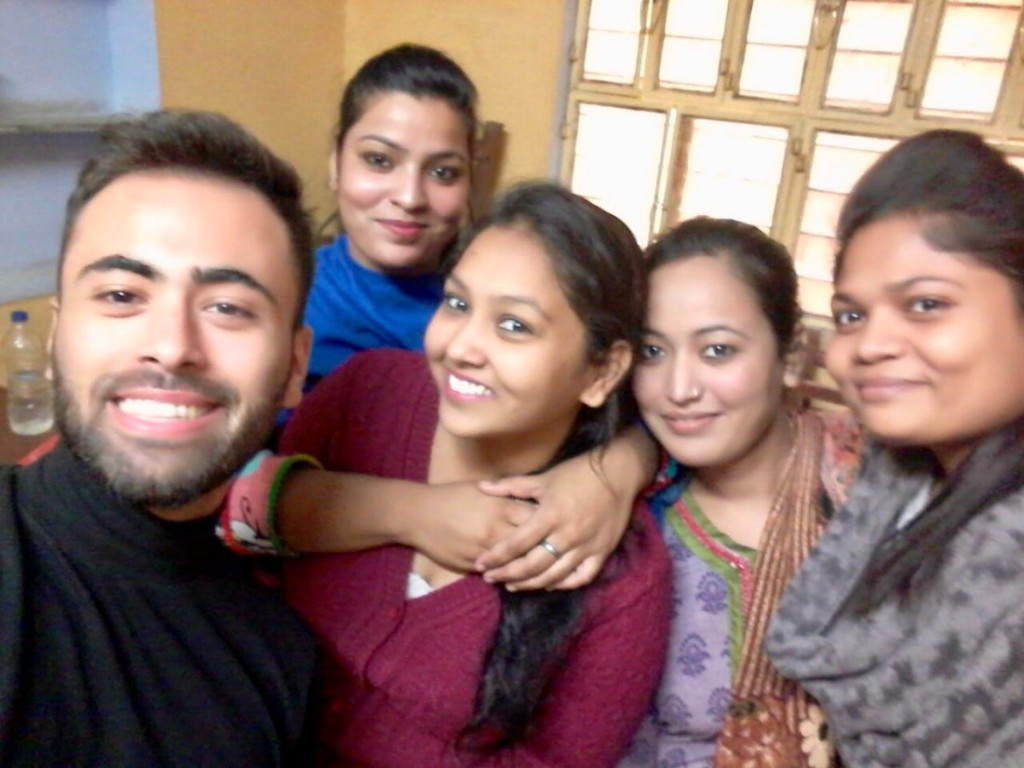
Post-class picture ❤
IT Skills and Class Presentations Before the Christmas Break
Three and a half months ago I first started writing my posts and it feels like yesterday. This post is the last post of 2017 and the last of my internship at the Tushita Foundation.
This week I wanted my students, especially the younger ones, to start using a computer and familiarise themselves with the procedure of searching and finding information online. This week’s task for the kids was to come up with a topic that they would like to present in front of the whole class the last day before the foundation closes for Christmas. Most of the students liked my recommendation for them to talk about their role models, people they admire or like and feel inspired by. From Steve Jobs to J.K. Rowling and Mark Zuckerberg, many famous and non-famous people who serve as an example of what a person can achieve if s/he works hard and stays committed, they were presented by students in the rose class.
Overall, their performance was quite good and they seemed to enjoy this sub-project. Some of them were shy in front of their audience (e.g. Prena), whereas other were quite comfortable (e.g. Lalit). The final result of their work reflected the improvement that they have shown since the beginning of our classes and this made me particularly happy.
Friday was my last day as a teacher at the Tushita Foundation and it had everything. Christmas celebration, gifts, role playing, games and fun.
Having the chance to be the Santa for this year’s festivity was a great experience. The excited faces of the students will remain in my memory for a long time…
Three hours of playing, dancing, eating and smiling. Three months of teaching, learning and making bonds…
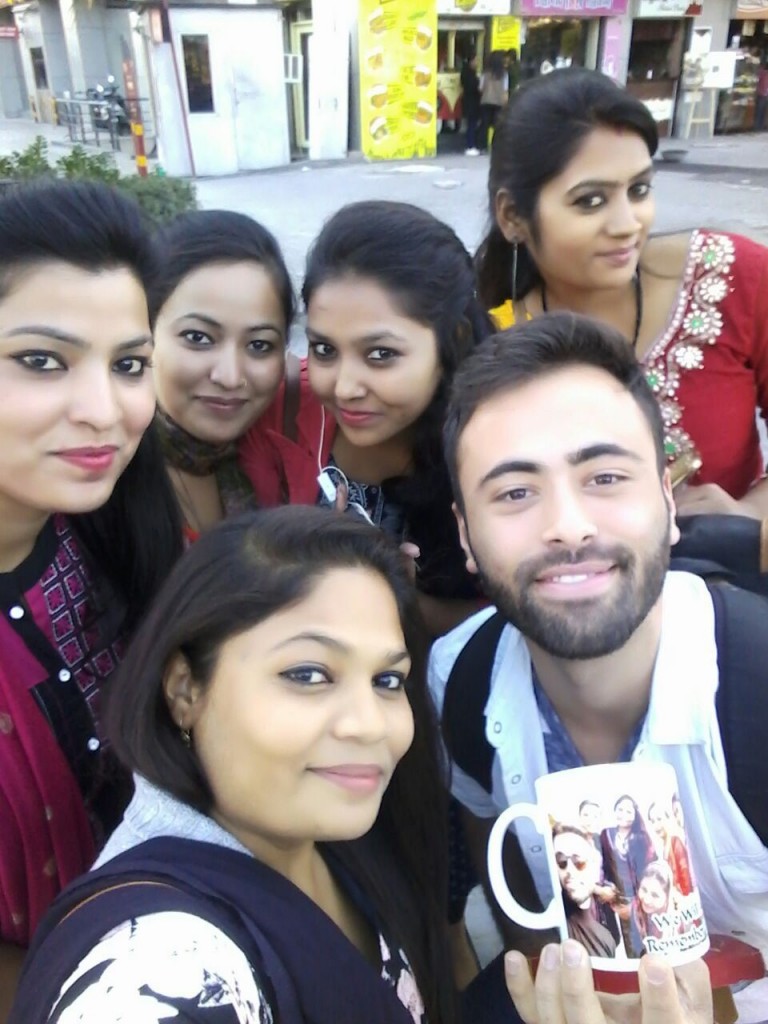
The best gift from the sweetest girls, my “grammar class” ❤
Images, colours and emotions in this post….images, colours and emotions during this internship…
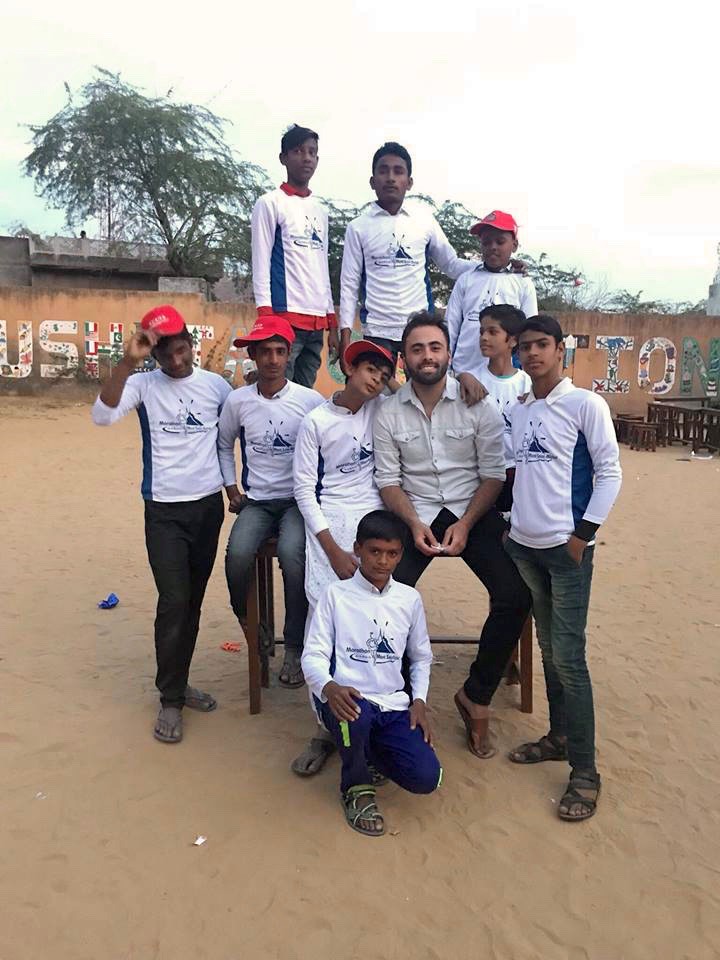
Kabbadi was our everyday ritual ! Playing together everyday after our classes is one the things that I will miss the most…
I came in India and at the Foundation as a teacher, to offer my knowledge. How am I leaving?
Better, grown and richer in experiences….
Until the time I return, as I promised….
Dimitris
24 December 2017

